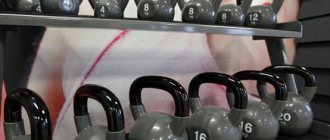The main goal of bodybuilding is to create an athletic physique through the harmonious development of muscles. For those who are engaged in building muscle and are constantly looking for effective exercises, we recommend paying attention to the “drop-set” (“drop-series”) technique. This scheme does not offer bodybuilders new non-standard elements, but it allows for qualitative improvement in the hypertrophy of muscle fibers.
What are drop sets
Everyone is familiar with the standard training method, when the athlete does a certain number of repetitions, gradually increases the weight of the apparatus and rests between each approach. This method of performing exercises loses effectiveness over time as a result of muscle adaptation to the same type of load. To “shock” the muscles and give an impetus to growth, drop series are used.
The technique involves performing each set in an exercise until muscle failure occurs. There is no recovery pause between approaches, and the weight of the projectile is gradually reduced (by 20–25%). As a result, an unusual load is created for the muscles, and muscle fibers that were not previously involved in the exercise are activated.
The definition may seem confusing and complex. To improve understanding, here's an example of a classic drop set.
Let’s take the “bench press” exercise. Let's say you do a bench press with 80 kg for 12 reps, and then you experience failure. At this moment, place the barbell on the supports, but do not remove your hands. Have partners quickly lose 10 kg on each side. After this, do a set to failure with a 60 kg barbell. The main thing is that the pause between sets is minimal.
Drop set for muscle growth on biceps
Let's look at how to properly perform drop sets for biceps. For example, consider the favorite method of training the famous Arnold Schwarzenegger with a barbell.
- Warm up with light weights to warm up your muscles. Usually this is an empty neck.
- Load the barbell with 4 weights (5 kg each) on each side. The total weight will be 60 kg.
- Work with this weight, performing 10-12 repetitions.
- Remove one pancake from each side one at a time, this will reduce the total weight by 15%.
- Work with a mass of 50 kg until the first failure, and again remove the plate from both sides.
- Perform lifts of 40 kg until exhaustion.
The example shows weights for strong, experienced athletes. If you have not yet grown up to such loads, take a small bar and small-sized weights. Although, if you haven’t grown up to such weights, then drop sets are of no use to you)
The significance of the technique
Drop sets in bodybuilding are used to increase muscle volume. The effectiveness of this training scheme for muscle growth is due to the following beneficial properties:
- Multiple microdamages of muscle fibers as a result of exposure to stress loads.
- Increased blood flow, facilitating the rapid flow of nutrients into the fibers.
- A powerful pumping effect (“pumping”) that helps to qualitatively improve muscle relief.
- Stimulation of the production of anabolic hormones as a result of prolonged forceful impact on the muscles.
Drop sets in strength training help overcome the “failure point” - the state in which an athlete cannot perform another full repetition. As a result, ligaments and tendons are strengthened and the neuromuscular connection is improved. All together this makes the bodybuilder stronger and more resilient.
Benefits and harms
Bodybuilders resort to this method if standard training no longer brings good results. Muscle mass does not grow for 3-4 weeks or working weight does not increase. And with the help of these techniques, athletes add variety to their training.
Using this method, the athlete quickly increases the mass and size of the trained muscle groups. These intense workouts can be used for both compound and isolation movements, at the beginning or end of a workout.
The disadvantage of this method is high overloads. This is a difficult test for the muscles and nervous system. I do not recommend including weekly drop sets in your training routines; this can lead to overtraining. It is enough to do them once a week, in one or two exercises for each muscle group. With such training, you need to monitor your nutrition, follow a high-calorie diet, including as much protein as possible in your diet for quick muscle recovery.
Varieties
We offer working types of drop series:
- Strip sets . The technique is similar to drop sets and is designed for muscle growth. Strip sets are exercises performed for 3-4 approaches until failure occurs in each. The weight reduction step is 15–25%. There are no pauses. Equipment used: barbells, dumbbells, kettlebells, block exercise machines. Example: bent-over dumbbell rows – 4 sets (18 kg, 15 kg, 12 kg, 9 kg).
- Tight drop sets . The execution scheme involves a smaller weight reduction step in the approaches - 5–15%. This allows you to increase the intensity of training, but at the same time increases the risk of overtraining. Tight drop series are usually used to work small muscle groups. Example: EZ-bar biceps curl - 4 sets (20 kg, 18 kg, 16 kg, 14 kg).
- Large drop series . The technique is based on an increased step of reducing weight loads - 30-40%. Large drop sets are used in strength training for mass. The advantage is that it works large muscle groups, the disadvantage is that it puts stress on the heart. Most often, this technique is used in basic elements. Example: barbell squats - 3 sets (100 kg, 70 kg, 40 kg).
- Method 6–20 or 50% drop series . The scheme involves performing only two repetitions, the difference in weight between which is 50%. The method combines a low-repetition strength approach with a high-repetition pumping set. As a result, the muscles receive a “shocking” load, which helps them grow. Example of a 50% drop series: T-bar row - 6 reps (60 kg) + 20 reps (30 kg).
- Power drop sets . The technique is based on working with heavy weights for a given small number of repetitions. The weight load reduction step does not exceed 10–15%. The method is intended to develop the athlete's strength abilities. The downside is the heavy load on the heart. Example: deadlift - 4 sets of 6 reps each (100 kg, 90 kg, 80 kg, 70 kg).
- Drop series with changing the position of the legs or grip . Used to work large muscle groups. The step in reducing weight loads is small - 10–15%. The method allows you to change the load on the muscles by applying different force vectors. Example: row of the bar towards you on the lower block while sitting - 3 approaches (wide straight grip - 35 kg, narrow reverse - 31 kg, parallel narrow - 26 kg).
- Triple and quarter drop sets . An expanded version of the classic drop series. The triple involves three approaches to failure with a decrease in weight by 25% for sets 2 and 3, the quarter involves the same thing, but for 4 sets. Used to increase muscle mass by creating a “shocking” load. Example of a triple drop series: overhead pull-down - 3 sets (45 kg, 34 kg, 25 kg).
- Progressive drop set . Combines several types and is suitable only for professionals. Let's explain using the bench press as an example. We do a warm-up approach. Then we select such a weight that failure occurs at the 12th repetition and do the classic drop series. We rest for 2–3 minutes. We set the “failure” weight for 8 reps and do a triple drop set. Rest again for 2-3 minutes. We set the “failure” weight for 6 repetitions and do a quarter drop series.
- Reverse drop set . It does not involve losing weight, but increasing it with each approach. The technique is designed to work out small muscle groups that respond poorly to loads. Example: calf raises in a calf machine - 1 set (20 repetitions), 2 approach (increase the weight of the apparatus and do 12 repetitions), 3 approach (increase the weight again and do 8 repetitions).
- Drop superset . The most powerful training option that literally “explodes” muscles. For example, let's take two exercises for antagonist muscles: dumbbell curls and French presses. We do 12 curls and 12 presses at once. We rest for 10 seconds, reduce the weight by 20% in both exercises and again do 12 repetitions. We perform 4 such super series with reduced weight loads.
Types of dropsets
Triples are a classic drop set, when the weight is dropped twice per approach, that is, three sets are obtained. Weight reduction occurs by 20-25%. Rest between resets ranges from 2 to 15 seconds maximum. Rest 1-1.5 minutes between sets.
Quadruples - the same as the previous option, only the weight is dropped one more time, thereby resulting in four sets. Likewise, weight is reduced by 20-25%.
Progressive - This method uses the first full warm-up set, then increases the weight and performs a classic triple drop set. Rest 60-90 seconds. Next, increase the working weight and perform a warm-up approach, then increase the weight again and perform a triple drop set, and do the same for the third approach. That is, here the weight increases with each approach.
Reverse - performed according to the triple dropset scheme, only the weight, on the contrary, increases. We take a small weight, perform 20-30 repetitions with it, then increase the weight, perform 6-8 repetitions, then take the maximum weight for 1-3 repetitions. Accordingly, sets are performed with minimal rest, but no more than 15 seconds. Rest between dropsets is no more than 90 seconds. This method is suitable for all muscle groups.
Drop supersets - performed as two exercises in a superset according to the principle of triple dropsets. For example, we perform a superset in a row: a barbell press and a dumbbell fly, then we drop the weight by 15% and immediately repeat the superset, while the pause takes 10-15 seconds, we reduce the weight again and perform the superset a third time. After performing the drop superset, you can rest for 2 minutes, then continue in the same way for another 1-2 approaches.
Nested - this type is performed in the same way as the triple classic dropset, but is applied only to one muscle group that is not involved in the training process. For example, split training is performed on the back and pectoral muscles. In this case, in the middle of the workout, you can perform a drop set on the lagging group, for example, the lower leg. That is, a muscle group that is not included in the work of the main complex.
SAT dropsets - in this case, perform the first basic exercise with maximum weight, for example, a deadlift. On the second approach, reduce the weight by 20% and perform 3-6 sets of 2-4 repetitions. Between approaches you rest for an average of one minute, but a maximum of one and a half. And here the negative phase will be the main one, here it is important to concentrate on quality, that is, during contraction you speed up the movement, and perform the negative or relaxation phase slowly and concentrated.
The difference between drop sets and negative reps
Drop series and negative repetitions are techniques that have a common purpose - “shocking” muscle fibers, but different methods of execution.
Drop sets are based on positive loads. That is, a force effect on the muscles is created when lifting the projectile (positive phase of the exercise). The result is the appearance of micro-tears in the fibers and the production of anabolic hormones. This contributes to a gradual increase in muscle mass, as well as the development of the athlete’s strength abilities.
Negative reps involve lowering the weight in a controlled manner. That is, first you load the projectile as much as possible, then, with the help of a partner, lift it to the highest point of the amplitude, and then very slowly lower it to the starting position.
The essence of the technique: intense stretching of the muscles while slowly lowering the projectile creates an extremely unusual load for them. Because of this, muscle fibers receive multiple microtraumas. In addition, the production of growth hormones increases. As a result, the muscles receive a powerful impulse to increase.
Both techniques place stress on the muscles. But do not forget that joints, ligaments, tendons, the heart, and the nervous system receive excess stress. Using drop series or negative reps too often can lead to overtraining. The latter threatens to stop progress, reduce strength indicators, deteriorate mood, disappearance of motivation for training, and general lethargy of the body.
The recommended frequency of using drop series and negative repetitions is once every 2–3 weeks.
How it works
The described technique rightfully refers to an effective way to gain muscle mass. In the case of classical training, your body begins to gradually adapt to the load offered to it. This adaptation is characterized by an increase in the volume of sarcoplasm, that is, the non-contractile part of the muscle fibers. Drop sets powerfully work more muscle joints. The muscles begin to work more actively, which stimulates their growth.
As an example, consider such a basic physical exercise as the bench press.
- In a typical bench press set, the weight lifted starts at, for example, 80 kg for 12 reps. On the first approach, the athlete takes the maximum weight and does the approach to failure.
- Upon completion of the last repetition, the athlete is no longer able to continue the approach. Then the assistants instantly remove the weight discs from the bar and 20-25% less remains on the bar—let’s say 60 kg. Thus, the practitioner can do about 3-4 more repetitions.
- This is followed by another reduction in weight by 20-25%, and the exercise is again continued until failure. All this happens without a temporary break and within one approach.
It is recommended to reduce the time between sets within an approach to a minimum, so in some exercises it is recommended to seek the help of a partner
Recently, scientific developments in this area have been added to empirical observations of the effectiveness of drop sets. Well-known fitness specialist Brad Shanfield in his report substantiated the productivity of using this method of strength training. In the presented experiment, 16 males were divided into 2 subgroups. Each of them conducted their classes in the gym using a separate method:
- The first subgroup of athletes performed triceps extensions from the upper block in the classic mode. Athletes did 3 sets of 12 repetitions with a 90-second rest break.
- The second subgroup of athletes performed a similar exercise of 12 repetitions, which included 2 drop sets.
The volume of load in both cases was completely similar, but after a month and a half, the subgroup of drop sets demonstrated almost twofold superiority in the growth of the triceps brachii muscle. This is because the Drop Sets technique enhances the anabolic response of the muscles. Its inclusion in strength approaches provides a sharp surge in growth hormone levels. Thus, the effect of the exercise on the muscle becomes much more comprehensive. The training stimulus increases, and along with it the volumes themselves increase.
Drop sets are especially good for small muscle groups (deltoids, biceps, triceps, calves), since when training them, significant changes in load may not produce any progress. In this case, “compressed drop sets” are used, i.e. slight weight loss, from 5 to 20%. For larger muscle groups (back, legs, chest), “wide drop sets” are used, where the weight is reduced by approximately 30%.
Rules for performing drop sets
Performing intense strength sets without pauses can cause injury. To prevent this, follow the recommendations:
- Prepare weights in advance so you don’t have to run around the gym looking for the necessary weights. Haste in working with iron often leads to projectiles falling out of your hands.
- Take breaks. Even if you are an experienced trained athlete, the first time you use drop series, add 10-15 second breaks between approaches.
- Select the correct weight of the projectile. The load on the first set of a drop set should be such that you experience muscle failure by the twelfth rep.
- Use the help of your partners. It is more convenient to perform the same bench press when colleagues drop weight between sets. This minimizes pauses and reduces the risk of injury.
- Do not use the drop set technique more than once every 2 weeks. Regular use of this exercise regimen can lead to the development of overtraining.
- Be sure to warm up before each session. Drop series are a power type of load, so unprepared, unheated muscles are easy to injure.
- Do not use more than 2 drop series per muscle group. Excessive overstrain of muscle fibers can cause the opposite effect - they will begin to break down.
- Do not use drop sets if you are a beginner athlete. Such techniques are contraindicated for beginners, as they create a large load on the heart and central nervous system.
Examples of drop sets[edit | edit code]
Drop set No. 1.
Especially if the number of repetitions in the 1st mini-set is small (4-8), it is suitable for increasing strength and muscle mass. This is understandable - the entire approach is carried out with significant weights, and, accordingly, the result of such sets will be an increase in strength and muscle mass. In this case, both approaches to failure and mini-sets “with a reserve” are suitable. By definition, there should not be many approaches to failure (two sets of two mini-sets can be considered sufficient to train a muscle group), but in the case of mini-sets “with a reserve” there may be more of them, since in this case the drop set is actually can be equated to the conventional approach. Pauses between mini-sets are acceptable in this case (no more than 15-20 seconds).
Technique
Take the bench press. Let's say 90kg is squeezed out 8 times, and this is the limit, or there is a small reserve left. Next, the weight is reduced to 80 kg and another 2-4 repetitions are done (more will not work). You can add another 2-3 repetitions with a weight of 70kg. As you can see, fewer repetitions are done in the second and third sets than in the first, and the weight loss is relatively small.
Drop set No. 2.
Suitable for muscle growth through sarcoplasmic hypertrophy, in addition, develops muscle endurance. Again, in this case, you can work to failure or not, with or without short pauses. There is hardly any hope for an increase in strength, but it will be possible to gain mass.
Technique
We take the same 90kg for 8 times, and then reduce the weight to 60-70kg and do it another 8 times. You can still lose weight and do about 8 repetitions again. In this case, the weight is selected in such a way that the number of repetitions in the mini-sets is approximately the same. The weight loss is inevitably greater than in example #1.
Drop set No. 3.
Questionable from an effectiveness point of view, and the greater the difference in the number of repetitions between the 1st and subsequent sets, the worse. This does not mean that the entire drop set is useless, it means that the 1st mini set is useless. Let's explain with an example. We take the same bench press 100kg for 5 repetitions, and then immediately 70-80kg for 15 repetitions. The fact is that 5 repetitions are a phosphagen (oxygen-free alactic) mode of operation, and 15 repetitions are an oxygen-free lactate mode. (link to biochemistry textbook). If two (or three) different modes of work are combined in one workout, then the result will not be progress in all exercises (as we would like), but in those where the power is less, that is, there are more repetitions (link to the table). In other words, the result of such a drop set will be the same as without 100kg in the 1st mini-set. It’s better to do something like 85(10)+70(10) - it will be more effective in terms of progress in this mode of work, and for strength work (with 100kg) you can allocate another training day or training cycle.
Technique
Press 90kg 8 times, reduce the weight to 50kg and press 10-15 times. (The third mini-set is unlikely to be appropriate.) That is, now the weight reduction is even more significant, and the number of repetitions in the second mini-set is greater (or significantly more) than in the first.
Popular drop sets
We offer examples of exercises often performed using the “drop set” method (the weights indicated are approximate, for a general understanding of how the weight load is reduced in the approaches).
To train deltoids:
- Arnold press (22 kg, 18 kg, 14 kg, 10 kg).
- Rest 1-2 minutes.
- Reverse abductions in an inclination (14 kg, 10 kg, 6 kg, 6 kg).
To work your biceps:
- Standing EZ barbell lift (20 kg, 16 kg, 12 kg).
- Rest 1-2 minutes.
- Lifting dumbbells with supination (16 kg, 14 kg, 10 kg, 8 kg).
To develop triceps:
- Close grip bench press (45 kg, 35 kg, 25 kg).
- Rest 1-2 minutes.
- French bench press (25 kg, 20 kg, 16 kg, 12 kg).
For chest training:
- Bench press (100 kg, 80 kg, 60 kg).
- Rest 1-2 minutes.
- Incline dumbbell flyes (18 kg, 16 kg, 14 kg, 12 kg).
To work your back:
- T-bar row (60 kg, 45 kg, 30 kg).
- Rest 1-2 minutes.
- Shrugs with dumbbells (20 kg, 18 kg, 16 kg, 14 kg).
For leg training:
- Smith machine squats (90 kg, 70 kg, 50 kg).
- Rest 1-2 minutes.
- Lunges with weights (18 kg, 16 kg, 14 kg, 12 kg).
What it is?
The phrase is translated from English drop - reset, set - install, accept. This is a method of strength training in bodybuilding, when the weight of the weight decreases as the exercise is performed and fatigue accumulates. An example of such a workout is shown in the video below.
Let me give you an example: you lift a thirty-kilogram barbell for your biceps. After 10 repetitions, the muscles got tired and failure occurred. Put down the barbell, take a 20 kg projectile and continue lifting the biceps to the limit, after which you will feel the arm muscles burning.
The use of drop sets in training programs
Bodybuilders use drop series in two ways:
- In the middle of a workout. The goal is to create a stress load that promotes muscle growth. Even experienced athletes do not do more than two drop sets in one session. Otherwise, the risk of injury and overtraining may increase.
- At the end of the workout. The goal is powerful pumping. It is believed that “pumping” exercises performed after main loads help muscles grow. This is explained by an increase in microtears obtained during the lesson, as a result of pumping a large volume of blood into the muscles.
In any case, drop series are used exclusively in training programs for experienced athletes. Beginners first need to strengthen their ligaments, tendons, and also improve their neuromuscular connection. Only after this can you begin more complex training methods.
Advantages and disadvantages
The advantages of drop sets include:
- Powerful stress load for muscles
This provokes better muscle growth.
- High energy consumption
Therefore, this method fits perfectly into terrain training.
- The ability to pump all three types of muscle fibers at once
Disadvantages include :
- Not suitable for beginners
Even intermediate levels should use it with caution.
- High risk of overtraining
Optimally limit yourself to using sets for 2-3 weeks. Then return to training according to the usual patterns.
- Complexities of the organizational plan
During rush hour, the gym simply may not have the required amount of equipment.
Using drop sets to lose weight and increase strength
When performing drop series, the athlete spends a large amount of energy to ensure long-term muscle work. As a result, calorie consumption increases exponentially. This really promotes weight loss, provided that such energy expenditures occur regularly.
But we have already said that frequent use of drop sets is dangerous for physical health. Therefore, the technique is not suitable as a basis for training programs aimed at losing weight.
But in powerlifting, drop series are quite actively used. For example, during periods between competitive cycles. This allows you to maintain the athlete’s strength characteristics and recover from injuries. The weight is selected so that the point of failure occurs at 5–6 repetitions in the set. But, again, such loads are used only by trained powerlifters under the supervision of experienced trainers and only a few times a month.
How to increase efficiency?
When performing isolation exercises for small muscles and training on machines, the weight can be reduced more gradually - by 10% at a time. In basic exercises, such a slight reduction in load will not allow you to repeat the movement; here you need to reduce the weight by 20-30% at a time.
Set with a 50% reduction in load. With this method you can use two opposing rep ranges. Each of them affects muscle fibers differently. This promotes the growth of muscle mass and the development of muscle strength and endurance at the same time. Select a load with which you can perform 6 lifts and do a set. Reduce the weight by half and do another 20 repetitions without resting.
Drop sets with modifications of exercises. I'll give you an example of chest training. First, there is a bench press 12 times with a working weight. Then, without resting, we pick up dumbbells and perform 8-10 arm raises to the sides, lying on a bench. Then we do bench presses with the same dumbbells until complete exhaustion. The use of different movements will allow you to maximize the use of all muscle tissue cells. After this approach, your muscles will simply burn.
For pumping your legs
A drop set for leg mass is also very effective, but for this it is better to ask for the help of a partner. Let's say you're doing machine leg presses for 12 reps with a weight of 120 kg. Do them, and then the assistant should remove a couple of plates, reducing the weight to 90 kg, and you immediately press again.
When failure begins, another 30 kg is removed and the cycle is repeated. If you still have some strength left, you can lose a couple more pancakes. Note that it is difficult to train legs with a drop set, since large muscles cause shortness of breath and require more endurance from the athlete.
bodynote.ru - Blogs of bodybuilders and athletes
The goal of any bodybuilder is to build muscle mass. There are techniques in strength training that allow you to quickly achieve tangible results - drop sets. This is one of the best bodybuilding techniques to stimulate muscle growth. Its essence is that the exercise is performed with maximum weight until muscle failure, after which the weight is reduced by 20-25% and the approach continues with a lower load. This method was discovered back in 1947 by the editor of the magazine “Body Culture” G. Atkinson. The method has other names: triple sets, decreasing sets, strip sets. One of the adherents of drop sets was Arnold Schwarzenegger, whose sensible advice remains relevant for fans of this technique. It is not suitable for ordinary athletes who strive to achieve results in increasing strength, power, and speed. In contrast, bodybuilders try to cosmetically improve body proportions and increase muscle size. Drop sets are great for building lean mass.
Execution technique
Let's say a bodybuilder lifts a 40 kg barbell. Having done 10-12 repetitions, he feels that this is the limit. He simply did not have the strength left to complete the 13th repetition. This condition is called “positive failure”. The muscles are able to work, but only with less weight. By reducing the weight lifted by 15-20%, you can continue training. When performing a classic approach to failure, not all muscle groups are activated. Only those muscle fibers that are necessary to lift a given weight a certain number of times are involved in the work. When removing excess weight, reserve fibers are recruited, drop sets activate them and cause growth that cannot be achieved with a standard set. It is recommended for experienced bodybuilders to include drop sets in their training program; it is not advisable for beginners to use them. Professionals advise using this technique periodically, allowing the body to fully recover. To avoid injury, drop sets should begin after a mandatory warm-up and warm-up. Typically, a drop set is done with dumbbells of various weights, with barbells, on machines, on bench press benches and with varying incline angles, on a Scott bench. The time between sets after removing the weight should be minimal. Exercise machines allow you to quickly lose weight, but there is an opinion that they give less effect than dumbbells and barbells. Drop sets for the deltoids and arms are considered the most effective. Varieties There are various options for performing drop sets that you can experiment with, changing them periodically.
Classic - the traditional way when the exercise starts with a large weight and then it is reduced after it is impossible to continue the repetitions. Then the training continues with the new weight as long as there is strength. With the triple method, weight loss occurs not once, but twice, with the quarter method – three times. With strict , each approach includes a certain number of repetitions. A super drop set involves performing one exercise to failure, then moving on to another with a lower weight, for example, from barbell arm exercises to dumbbell exercises. Reverse drop sets are similar to triple sets, in which the weight is dropped twice in one set, but everything happens exactly the opposite. From set to set, the weight does not decrease, but increases. The first set is 20 reps, 10 seconds rest. After taking a heavier weight, perform 5-10 repetitions, 10 seconds pause. Add weight and do 1 to 4 more reps. The 6-20 Method involves performing a set of 6 reps using a heavy weight, then halving the weight and performing 20 reps.
The most interesting and creative ways to train
1. Strip sets with a barbell. One of Schwarzenegger's favorite methods. The basic principle is to reset the discs when the body reaches failure and continue training. Let's look at an example. Let's say that at the beginning of the bench press the weight is 50 kg. The bar itself weighs 20 kg and 15 kg on each side. To make it easier to reduce weight, it is better to take 5 kg discs.
After completing 10-12 repetitions and reaching failure, you need to remove one disc at a time, that is, reduce the total weight by 20%. With a weight of 40 kg you continue. Having reached the next failure, again reduce by 20% of the original weight, removing one disk from each side. Now the weight is 30 kg, and with it you move to the point of the next, last, failure.
2. Drop sets using dumbbells. It will be convenient to perform these exercises while being next to a rack with dumbbells, which allows you to quickly change the load. Start with 12kg dumbbells, then move on to 10kg and finish the set with 8kg. With this technique, the deltoids and biceps are perfectly worked out, the shoulders and arms are pumped up like balloons.
3. Drop sets on simulators. Compared to barbells, working out on block machines by moving the pin up the block is much easier. Without the help of a partner, you can pull out the pin and quickly change the weight to a lighter one. This procedure can be done on a simulator designed for leg extension without even leaving it.
4. Drop sets are compressed. It takes a complex and intensive approach through small weight reductions (5 to 20%). They are most often used for isolation exercises and small muscle groups.
5. Drop sets are wide. Reducing heavy weights allows you to do more repetitions. Such techniques are used where large muscle groups are involved (bench press, squats, leg press, bent over barbell lift). Overall weight is reduced by approximately 25%.
6. Drop set 50%. It is also called the “halving method.” This method involves performing two completely opposite repetition ranges. Each has a different effect on the muscle cell, but both promote muscle growth.
First, select a weight with which you can do a maximum of 6 repetitions. After completing these 6 repetitions, the weight is halved and 20 repetitions are performed. Usually in other techniques the weight is reduced twice per set, that is, three different weights are taken. Here the weight is reduced only once.
7. Drop sets are powerful (low rotation). According to the first Mr. Olympia, Larry Scott, when lifting heavy weights, low reps (6) are the best way to simultaneously build size and develop strength. Using this technique, he developed powerful deltoids and arms. At 6 reps, heavier weights are used to help thicken muscle fibers and maintain strength. You should do 6 repetitions, then reduce the weight by 10-15%, perform another 6 repetitions, and then reduce the weight again and do the same number of repetitions.
8. Drop sets decreasing (according to the 12-4-2 system) and increasing (according to the 6-12-20 system) . In decreasing drop sets, very similar to compressed ones, there is a slight decrease in weight (by 5-10%). The number of repetitions decreases with each subsequent drop set, and 4 different weights must be dropped three times. With each of the weights you need to do the number of repetitions in the following order: first 10-12, then 6-8, then 4-6 and finish with two.
In increasing drop sets, you should reduce the weight enough to achieve a significant number of repetitions. As a percentage, this is two times 25-30%. The very first weight should be the largest, with 6 repetitions performed. After reducing the weight, 10 to 12 repetitions are done, the weight is dropped again and another 15-20 repetitions are performed.
9. Drop sets with changing the position of the legs and grip. They allow you to hit multifaceted muscles from different angles. For example, when performing the leg press exercise, depending on the position of the legs on the platform, the load can be concentrated on the lateral, medial, intermediate muscles, buttocks, and femoral biceps. When performing exercises, the number of repetitions remains the same, only the body position changes.
You can start the exercise by placing your feet in the middle, shoulder-width apart. After completing 6-12 repetitions, reduce the weight. Raise your legs higher on the platform (the position remains shoulder-width apart). Do the same number of repetitions. After this, reduce the load again, lower your legs to the bottom of the platform, put them together and perform the same 6-12 repetitions.
Do the last set after dropping the weight with your legs wide apart (toes turned outward) and perform the next repetitions. Using 4 different weights and changing your leg position four times, this workout will help your thighs grow from the inside out and from the top down!
10. Drop sets are zero. This method, in which the rest time when changing weight literally approaches zero, is very difficult, which is why many bodybuilders avoid it. Two assistants are required, since one partner is not enough for such training.
For example, when performing a leg press, you need to stand up, take turns removing the weight from both sides of the machine, and sit down. This takes at least 10 seconds. The presence of assistants will reduce to a minimum the time interval between changing weights on the locking levers. Continuous, intense drop sets can be the most intense and challenging workout.
11. Drop sets using the rest-pause method. In contrast to the previous method, you don’t have to strain yourself too much here, because you only have 15 seconds to lose weight. A leisurely pace allows you to gain strength before using the next load. This method increases strength and engages hard-to-reach fibers.
12. Drop supersets. It uses a combination of two effective bodybuilding methods. Choose any two exercises. You should do one of them first. After failure, without reducing the weight, perform another exercise where the weight is lower. For example, you decide to do seated dumbbell presses and dumbbell lateral raises. Using maximum weight, do lateral raises. 8-12 reps Without wasting any time, move on to dumbbell presses using slightly lighter weights. Do the same number of repetitions. Without resting, return to dumbbell lateral raises, but use less weight. Perform regular 8-12 reps and then return to pressing with lighter dumbbells. Finally, perform the dumbbell lateral raise one last time, releasing the weight once again.
Having completed the exercise to failure, proceed to the final stage - reduce the weight and perform a seated dumbbell press. This entire strenuous workout counts as one set. This method is very intensive and cannot be performed without preparation.
Useful tips
To achieve maximum efficiency when performing drop sets, certain rules should be followed:
• Preparation of equipment In order not to waste time when changing weight, the equipment must be properly prepared in advance even before starting the exercise. So, you need to take small disks for the barbell, weighing 5 and 10 kg. Triple dumbbell drop sets require three pairs of dumbbells; they should be laid out in a row on the rack.
• Short rest Rest when changing weight should be as short as possible, in the range from 0 to 10 seconds. Even when performing heavy drop sets, you should take a minimal break. The shorter the period of time when changing weight, the more effective and intense they will be.
• Triple drop sets The weight can be dropped many times at your discretion, but there is a concept of “diminishing returns.” Once this is achieved, further repetitions become ineffective. The best option is to use three different scales, with the weight being reset twice.
• 6-12 Rep Range This is the most productive bodybuilding range for drop sets if hypertrophy is the goal. Try to stick to it. To maintain and develop strength, a range of 4 to 6 repetitions is ideal. To achieve relief and detailing of all muscles, you can sometimes raise the bar to 15-20 repetitions, especially when taking the last drop weight.
• Using maximum weight Using just 6-12 reps is not enough. It is necessary to achieve muscle failure. The effectiveness of performing drop sets will be minimal if you select a light weight from the beginning of the workout. When performing the actual six repetitions, you should feel that you can no longer do the seventh repetition, that is, reach complete failure.
• Moderate Use of Drop Sets One of the most intense and intense techniques in bodybuilding requires common sense and extreme caution. By using drop sets too intensely, you can overtrain and bring your body to the point of exhaustion. Under no circumstances should a day's workout consist solely of drop sets. The best option for using them is the 3:1 method. In this case, three regular approaches are performed per exercise and one drop set.
To avoid getting negative results instead of positive results, intensive methods should be used in moderation. You need to take weights that you can handle and confidently perform all the repetitions. It is necessary to gradually increase working weights.
• Compliance with safety precautions To avoid injury, do not violate the technique of performing exercises. These techniques should not be used in cases where it is not possible to throw (release) the weight without getting injured. It is dangerous to use drop sets in squats, bench presses, etc.
Complex from Arnold Schwarzenegger for biceps using drop sets
1. Lifting the barbell. In each of the 4 approaches, 6-8 repetitions are performed.
2. “Hammer”. Perform 4 sets of 8-10 repetitions.
3. Lifting dumbbells. 3 approaches are performed in turn. In the first, you need to do 8-10 repetitions (to failure), change the dumbbells to lighter ones, and perform the approach again to failure. Do the third approach with even less weight. This drop set must be repeated 2-3 times.
With dozens of existing high-intensity training methods used by bodybuilders, using even one of the drop set techniques is enough to achieve significant muscle growth in a short time. By using several different methods, you can achieve amazing results.
Video, Arnold Schwarzenegger talks about drop sets










